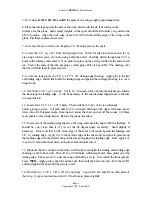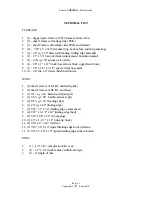
Lanier - SHRIKE 40 - Instructions
Page 9
Copyright 1998 - Lanier R/C
5. Assuming that the fuselage is painted or covered, peel off one side of the tape supplied.
Locate one end of the tape at the back edge of the nose block. Place the rest down the center
of the fuselage towards the tail. Now pull off the rest of the paper and stick down the strip of
plastic on it. This skid will protect the bottom when landing.
6. Assemble and prepare the fuel tank for installation. Cut a l' length of fuel line in two. Place
one piece in each of the fuel line holes in the firewall. Pull them through until they can be hooked
up to the tank. One on the vent and one on the clunk line. Wrap each line at the tank with a
nylon zip tie to hold the lines on.
7. Now grab the two lines at the firewall and pull the tank into position. Mount the tank as high
as possible blocking it up with foam.
8. As a start, locate the receiver batteries under the fuel tank. You may find it will be
necessary to shift it to another location when balancing at the CG shown on the plans.
9. Mount the throttle servo where shown. Hook up the pushrod using the hardware specified
not supplied.
10. Mount the aileron and elevator servos. Hook them up with the hardware specified. It will
be necessary to make a slot in the section behind the aft edge of the hatch to accept the elevator
pushrod. You will have to put a slight bend in the rod to clear the hatch. If you are using two
aileron servos, mount the servos in the wings and run the wires into the fuselage. Use (2) 4-40
control rod and an aileron horn set as shown on the plans.
11. Trim and install the canopy where shown on the hatch. Use Zap New Formula 560
Canopy Glue to hold it in place. If desirable install a pilot of your choice.
PRE-FLIGHT NOTES
Before the first flight, and to ensure some longevity in your Shrike 40, you will do well to check
out a few things before heading to the flying field.
1. Balance the Shrike 40 at the indicated CG point shown on the plans with the fuel tank empty.
Depending on your type of flying you may want to adjust it forward some.
2. Check the control surface travels. We have given you a starting point however, they need to
be fine tuned to meet your flying needs.
3. Run the engine and check the idle. Have it ready so you don't encounter any problems at the
field.































